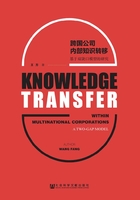
1.2 Research Question and Purpose
In order to overcome the trade barriers(mainly refer to the tariffs)among countries’ borders,MNCs continually set up overseas subsidiaries. Formulating different strategy to fit local specific situation under the unified leadership of the(HQ),guaranteed efficient subsidiaries management efficiently and enhanced the competitiveness of products and services which could ensure overall competitive advantage of MNCs. As a fundamental source of enterprise competitive advantage,efficient knowledge transfer between MNCs’ HQ and overseas subsidiaries will be large advantage for MNCs which want remain fierce global competition. Since 1990s,MNCs internal knowledge transfer has become a hot issue in some research fields,such as strategic management,MNCs’ management,knowledge management and capacity management.
This book mainly discusses knowledge transfer within a MNC,especially between HQ and overseas subsidiaries. We explore a conceptual framework of intra-MNCs knowledge transfer focusing on the knowledge transfer outcomes(called knowledge gap)between sender(HQ)and receiver(overseas subsidiaries). In the process of knowledge transfer within a MNC,we found that there are two potential problems,or gaps. One is called “communication gap”,also referred as “geographical gap”,and the other one is “culture gap”,which can be called “psychological gap”. In order to achieve the goal of knowledge transfer,the relationships among them were studied by discussing knowledge transfer considering these two gaps,sender and receiver. The design background and reference of this model are based on the Knowledge Transfer Analysis(KTA)framework,which is proposed by Vito Albino et al. in 1998.
Albino et al.(1998)suggested that KTA framework is quite representative and extensive. It is composed of 4 parts:the main actors of transfer(actors),transfer media(media),the content of transfer(content)and transfer context(context). The KTA framework is important for the research of knowledge transfer,because it points out the system structure of knowledge transfer,which provides strong support for the theoretical analysis.
Among them,the main actors of transfer,the transfer media and the content of transfer,are called the security factors of knowledge transfer which are necessary condition for occurring knowledge transfer. The influence of various factors on knowledge transfer exist in the transfer context. The main factors from the internal situation include knowledge culture from inter culture and value dimensions,strategy of knowledge management from strategic dimension,knowledge transfer evaluation and incentive system from knowledge transfer management control dimensions,knowledge transfer management team and so on. The main factors from external context include knowledge economy from social economic context and the industry or high-tech industry knowledge from industry characteristics. These situation factors playing a role in promoting and improving knowledge transfer activities are called the promotion factors of knowledge transfer. The final achievement of corporation knowledge transfer activities will be determined,through the interaction of these two factors. This book proposed a third factor which is called barrier factors to improve the KTA framework from the perspective of knowledge transfer receiver.
Different from the previous studies’ research orientation,we focus on gaps between HQ and foreign subsidiaries. In order to develop a new model explaining knowledge transfer between MNCs’ HQ and foreign subsidiaries,we reviewed related international business journals. Based on this theoretical background,we designed a conceptual framework of intra-MNC’s knowledge transfer. We conceptualized intra-MNC’s knowledge transfer as a process of knowledge gap reduction. In the other words,through the activities of knowledge transfer,MNCs could overcome various barriers factors and reduce the knowledge gap between HQ and subsidiaries. The more successful the knowledge transfer is,the more the knowledge gaps are reduced. This study,therefore,conceptualized a knowledge gap(between HQ and overseas subsidiaries)as an outcome of knowledge transfer. The goal achievement of knowledge transfer is possible by reducing knowledge gap between HQ and overseas subsidiaries. Thus,this study will address the following research question(RQ):
RQ:How can international firms reduce the knowledge gap?
Based on the KTA framework,we designed the intra-MNC’s knowledge transfer framework which is also composed of 4 parts:transfer actors known as “the HQ and subsidiaries”,transfer content called “the knowledge gap”,transfer media refers to “the communication gap”,and transfer context which is “the culture gap”. The highlight of this book is to develop and test MNC’s KTA framework,and answer above research question under an integrated research framework. This gap based framework offers a dynamic view of knowledge transfer and depicts causal relationship between transfer success and the influential factors,however,it should be noted that most of them were not empirically tested or validated.
In the context of the above discussion,this book has three purposes. First,it aims to help the better comprehension of international knowledge transfer within a MNC. So it tried to find various factors including internal and external ones through a comprehensive review of top management and international business journals from 2000 to 2014. The literature review successfully identified 12 key determining factors of international knowledge transfer. Second,based on the identified key factors,this study will develop a conceptual model(Two-gap Model),explaining the intra-MNC’s knowledge transfer,which is more concise and comprehensive than the KTA framework. Third,based on the Two-gap Model,this research is going to put forward several propositions which depict how to reduce knowledge gap between HQ and overseas subsidiaries.